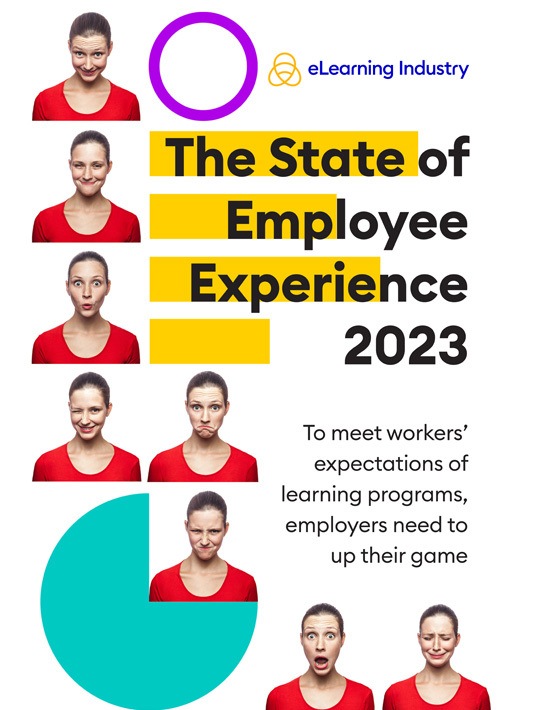All You Need To Know About Onboarding New Employees
Going through an entire hiring process only to lose an employee after a few weeks to a competitor is a huge waste of resources. To avoid this, companies are actively trying to optimize their onboarding process to make sure new hires quickly become valuable and engaged members of their organization. In this article, we talk about everything you need to know about the topic, from the onboarding definition to benefits and tips to create the most suitable onboarding experience for your organization. Let's dive right in.
What You'll Find In This Guide:
- What Is Employee Onboarding?
- Onboarding Vs. Orientation
- What Is The Scope Of Onboarding?
- Why Is Employee Onboarding Important?
- 5 Steps For A Successful Employee Onboarding Process
- What Is The Duration Of New Hire Onboarding?
- Best Practices For Effective Employee Onboarding
- A Good Employee Onboarding Process Flow
- The Changing Face Of Employee Onboarding
What Is Employee Onboarding?
The duration of the employee onboarding process can differ from company to company, as can the individual steps the HR team takes. Some organizations take a few days, while others take a year. Generally, onboarding begins when you extend an offer and continues until the employee can work independently and contribute significantly to their role. Catching a candidate's attention by expressing your company values before stepping into the office can significantly impact their subsequent engagement.
Definition Of Employee Onboarding
What does onboarding mean? Contrary to popular belief, onboarding is much more than signing paperwork on the first day in the office. This term refers to a lengthy process that introduces and integrates new hires into their work environment. During this time, employees acquire the necessary knowledge, skills, and resources they need to be productive in their position. In addition, during the onboarding process, employees learn about the company's values, objectives, and corporate culture and how their role can contribute to achieving the overall vision.

Onboarding Vs. Orientation
Often, businesses use these two terms interchangeably. However, such an approach could have a negative impact on the process of welcoming a new hire into the business. As we mentioned earlier, onboarding refers to a long series of events that help employees gain the necessary knowledge, resources, skills, and insights into their role so that they quickly achieve independence and productivity. On the other hand, orientation typically lasts for a day or two and refers to the initial welcome employees receive. It usually includes meeting new coworkers, getting an introduction to the company's core values and mission, and signing necessary paperwork.
Therefore, it's easy to see that orientation is not the same as onboarding but rather part of it. Considering that both processes are essential for a smooth transition into a new role, having a deep understanding of them will help you create an enjoyable work environment for your employees.
What Is The Scope Of Onboarding?
The scope of onboarding includes all activities that help new employees integrate into an organization: paperwork, training, introducing company culture, systems education, role clarification, team introduction, goal setting, equipment setup, assigning mentors, and collecting feedback to ensure a smooth transition to productivity.
Why Is Employee Onboarding Important?
We keep saying how necessary onboarding is for your organization's success and efficiency. But what makes it so important? Now that we've explored the meaning of onboarding, let's look at some of the benefits an effective employee onboarding program can bring to your business.
1. Enhanced Employee Experience
The high demand for talent means that employees have no shortage of opportunities. Therefore, if the employee experience you created for them is subpar, they will quickly leave. A robust onboarding process that delves into company culture, career growth opportunities, and mutual communication shows your employees that you are invested in their development and will continue to support them beyond their first months.
2. Reduced Turnover Rates
Businesses face the costly challenge of employee turnover, primarily due to employees' short tenures and ongoing hiring processes. Thankfully, training is one of the most valuable tools in combating this. Specifically, when employees feel that their professional development is supported by their work environment, they are more likely to stay committed to their company. Being able to do their job efficiently and grow their knowledge and skillset keeps them satisfied and productive.
3. Easier Talent Attraction
We all know that word gets around when a company creates a hostile work environment. Well, the same happens for the opposite. If you create an engaging onboarding strategy that caters to your employees' needs, you will achieve better retention and build your brand image. Modern employees are highly attracted to quality corporate cultures and training opportunities, making them eager to join your team. Not to mention that this technique of sourcing talent is faster and less expensive than a traditional hiring process.
4. Increased Productivity
It usually takes some time for new hires to start adding real value to their company. Besides, for the first few months, they're trying to find their footing and discover the best ways to perform their daily tasks. A thoughtful onboarding process for employees can significantly reduce the "settling-in" period and enable them to start working immediately. To achieve that, communicate frequently with your employees, set goals, define your expectations, and create a plan to maximize performance. This way, you will help them tap into their maximum capabilities sooner rather than later.
5. Robust Company Culture
It's obviously crucial for your candidates to have the proper skillset for the position you're offering. However, it's even more important that their personality fits your corporate culture. Incorporating your core values in the recruitment and onboarding process ensures you attract and hire the right people. As onboarding progresses, these new hires can quickly become part of the team and proud representatives of your company's values.
5 Steps For A Successful Employee Onboarding Process
Now you know the definition of onboarding and why your company needs an onboarding system. But how can you get all the benefits we described? Here are five steps to developing an effective employee onboarding program.
1. Demonstrate Your Company Policies And Benefits
Since no two companies are alike, new hires must understand what makes your organization unique from the outset. Make sure to describe the benefits, bonuses, and perks one gets working with your company early in the recruitment process. This way, you get ahead of the competition and attract more talent. It's also essential for the onboarding material to cover company policies regarding health and safety, compliance, best practices, etc., to avoid mistakes caused by ignorance.
2. Provide Role Clarity
Often, the job descriptions candidates view during the hiring process give a very broad image of what they should expect regarding the responsibilities of their new role. Thus, you must clarify roles for new hires so they feel confident and ready to work. You can achieve that by discussing general tasks, objectives, and responsibilities during the first days and weeks, and how these contribute to the company's overarching goals. Don't forget to provide them with access to all the resources they need to perform their tasks best.
3. Facilitate Training
As employees get used to their new work environment, having adequate guidance and support determines their future productivity and devotion to the company. Therefore, training must be your number one priority during onboarding. Make sure to create a personalized schedule that new hires can check so they know what to expect. Offer various training methods to accommodate your employees' learning needs. Finally, check in regularly with them to track their training progress and show them you're always available to discuss plans or issues.
4. Induct Into Organizational Culture
Businesses often do not include organizational culture in their onboarding training material, as they believe that the information is something employees will learn as time passes. Although that's true, pushing them in the right direction is wise. During onboarding meetings, explain your company's system of beliefs and values, the policies you follow, and how you interact. This will make it easier for them to assimilate into their work environment and form stronger relationships with colleagues and customers.
5. Promote Social Connections With Colleagues
Being the newcomer at a company where people have worked together for a long time can be lonely. To avoid social isolation, especially at a time when remote work is rising in popularity, make social interactions part of your onboarding process. Pair your latest team member with an onboarding buddy who will work them through processes, answer questions, and introduce them to the rest of the colleagues and your inner corporate culture. The buddy system can last a couple of months, but it will possibly create long-lasting relationships for the new hire.
What Is The Duration Of New Hire Onboarding?
The duration of the new hire onboarding process varies, depending on the organization and role complexity, but typically follows these timeframes:
- Administrative onboarding
This step takes 1–2 days and includes paperwork and basic systems access. - Functional onboarding
This process takes 1–2 weeks and includes job training tools and strategies. - Cultural onboarding
This process takes 30 to 90 days and includes team integration and cultural alignment. - Complete productivity onboarding
This final phase takes place in about three to twelve months and involves complete role mastery.
Many companies follow a structured 30-60-90 day plan, with formal onboarding activities concentrated in the first 90 days. However, specific, specialized, or senior roles with significant responsibilities may necessitate a 6–12-month period to complete onboarding. According to research, this trend of viewing onboarding as an extended process improves retention and productivity.
Best Practices For Effective Employee Onboarding
The onboarding steps we describe above are a general guide you can use to start your employee's professional journey in a positive way. But before you get started, take a look at these seven best practices that will create a better onboarding experience for your new employee and better results for your business.
Match The Job Description To The Job
It is an HR recruiter's responsibility to make job descriptions sound appealing to candidates in order to attract more talent. However, you must make sure to stay as close to reality as possible. If a new hire realizes that their actual position has nothing to do with what was advertised to them, it's possible that they will make a quick exit.
Automate And Personalize The Onboarding Process
If you're considering optimizing your employee onboarding process, a Learning Management System is the best investment you can make. An LMS will help you automate many onboarding steps, set specific standards, and easily keep track of progress. In addition, it facilitates personalization, as you can use its various tools to create versatile onboarding courses depending on your employees' interests.
Action An End-To-End Onboarding Schedule And Stick To It
When it comes to onboarding, it's always better to have a concrete plan. Employees need to know what to expect during the first few months of their employment so that they can self-assess their progress. Having a schedule is also beneficial for your business, as it allows you to monitor the process and take any necessary steps. Finally, a plan ensures that all new employees receive the same training.
Prioritize The Flow Of Information
Starting at a new company is a stressful situation. There's so much to learn and so many people to meet. Having said that, keep in mind that you need to control the flow of information your new hire receives. Although the company's full goal plan for the next year is important to know, maybe start with what time they need to show up for work or how to request days off.
Conduct A Meet-And-Greet
During hiring, a meet-and-greet introduces candidates to their potential colleagues, thus helping you gauge whether they would be a good match for the rest of their team members and if they could fit into the corporate culture in general. Later, during the first weeks of employment, meet-and-greets are used to establish relationships between the new hire and the people they will collaborate with in the future. Encourage employees to accept meet-and-greet requests to strengthen teamwork and collaboration within the organization.
Avoid An Isolating Onboarding Experience
As we mentioned earlier, starting a new job can be a rather stressful situation for many. Although using tools to automate the process is necessary, make sure not to leave your employees alone during that time. Plan frequent check-in meetings to discuss their progress and give them room to ask questions and talk about their future in the company. This way, they will quickly overcome their initial stress and move on to assimilating and becoming productive.
Measure Onboarding Metrics
The best way to ensure that your onboarding process is effective is to set metrics that you frequently analyze and compare. There's a lot you can measure during onboarding training, such as clock-in and clock-out time, goal progress, the time it takes to complete tasks, assessment scores, and much more. Use your LMS to automate metrics reports and keep a close eye on the development of your latest addition.
A Good Employee Onboarding Process Flow
1. Releasing The Offer
Prepare a comprehensive offer package including compensation details, benefits, start date, and job description. Ensure the offer is personalized and professional and outlines all expectations. Have a structured follow-up process to answer questions and address concerns.
2. Offer Acceptance
Once the candidate accepts, send a welcome letter with the next steps to follow, as well as pre-boarding information. Begin background screening and paperwork collection. Finally, create an onboarding plan specific to the role and assign a mentor.
3. Waiting Period
Maintain engagement with the candidate throughout the notice period with regular communication. Share relevant company updates and team introductions. Also, make sure to send a detailed schedule a week before joining to reduce anxiety and build anticipation.
4. The Day Of Joining
Ensure your new hire's workspace and equipment are fully prepared. Schedule a warm welcome with the team and key stakeholders. Complete essential paperwork and set up system access. Include a comprehensive office tour and overview of practical matters like building access and emergency procedures.
5. Coordinating With Other Departments
Establish handoffs between HR, IT, facilities, and the hiring department. Create automated workflows for setup requests and access permissions. It's also important to schedule introductory meetings with cross-functional teams relevant to the role.
6. Training And Orientation
Provide structured, role-specific training alongside company-wide orientation. This should include learning about the company history, values, and culture. Incorporate interactive sessions and varied learning methods to address the needs of your new hire. Finally, create a documented training plan with clear milestones.
7. The First Quarter
Implement a structured 30-60-90-day plan with regular check-ins and feedback sessions. Set progressive performance goals and learning objectives. Don't forget to schedule formal reviews at intervals to evaluate progress and address concerns.
The Changing Face Of Employee Onboarding
Modern employee onboarding has evolved beyond simple orientation into a strategic, ongoing process that significantly impacts retention and productivity. Today's effective onboarding combines digital efficiency with human connection, extending beyond paperwork to encompass cultural integration, relationship building, and continuous learning. Organizations now implement personalized journeys with structured timelines, clear milestones, and regular feedback mechanisms.
The rise of remote and hybrid work has accelerated digital transformation in onboarding, with companies leveraging technology to create consistent experiences regardless of location. Forward-thinking organizations view onboarding as a critical business process worthy of investment and improvement. They recognize that new hires' early experiences profoundly shape their engagement and success. So, what are you waiting for?
Conclusion
A well-planned onboarding process can give new employees the motivation they need to become not only long-term members of your organization but also valuable additions that contribute to organizational success. If you want to stop the vicious cycle of high turnover and wrong hires, follow the advice we shared in this article and develop an onboarding program that will attract and maintain the right people.
Visit our employee onboarding software directory to find the system that's just right for your organization. You can filter results by features, deployment type, and pricing model to simplify your search!








